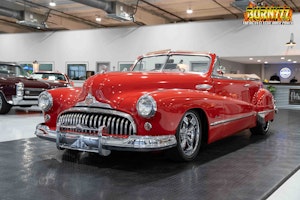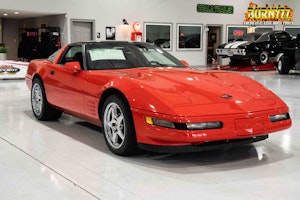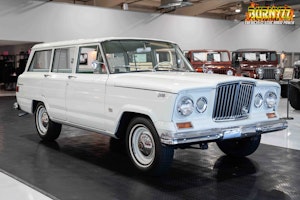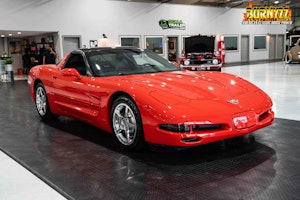Media | Articles
6 easy adjustments to change any car’s performance character
We all like to play pretend and be race-car drivers, even when we actually are race-car drivers. Adding a little more aggressive feel to your car’s handling can really enhance the experience of driving, whether you have a modern, four-cylinder boringmobile or a vintage car that you would like to elevate from stylish to focused.
Regardless of your candidate, here are six great places to start dialing up the fun factor of the driving experience. They range from pretty cheap to medium money plus large time investment. Give them a read, and you might just find your next winter project.
Alignment

Production cars balance efficiency with stability, but with a few turns of their tie rods, you can give one a more aggressive personality. Whether you’re looking for quicker turn-in or more stability at high speed, the vast majority of production cars have enough built-in adjustability to accomodate you.
Research how the three options for front-end alignment influence driving feel. (Brush up on the terminology here.) Then contact an alignment shop to get your car dialed-in to your custom specs. The nice thing about this option? The changes are easily reversed.
Ignition timing

Much of engine tuning is based on safety. Not preservation of the occupants’ lives, but the wellbeing of pistons and valves. Factory specs may be conservative, but know that if you push too far on timing it can be an expensive adventure. Proper timing can give you more power, so optimize the ignition timing for your engine modifications. This is especially easy for distributor-equipped engines, but learning to tune with a laptop is not nearly as scary as some would lead you to believe. Classes and tutorials are out there for various programs tailored to modern performance cars.
Marketplace
Buy and sell classics with confidence
Suspension bushings

Eliminating play or slop in the pivot points of your suspension will really tighten up the feel of your car. It will also dial the noise, vibration, and harshness up significantly. Fresh rubber bushings go a long way into making a tired car fresh again, and stepping up to polyurethane bushings will produce an even stiffer ride. Be careful here: You may be tempting to put poly bushings everywhere, but those may be overkill for your project or simply ill-suited to your driving habits and local roads. Every type of modification is a compromise; this is one that can be a pain to undo.
Shocks and/or springs

Minimize the body roll of your car and suddenly your car feels ready to take on Le Mans. Well, almost. Many modern cars accomodate bolt-in coilovers that allow for heaps of adjustment and tuning after the fact. For classic rides, you may have to commission custom coil or leaf springs, but the good news is that the work is often more affordable than you might fear. Combine fresh springs with a good set of shocks, and you will find yourself seeking out on-ramps and curvy roads with more confidence than ever.
Gear Ratio

We all want more power—more faster is more better, obviously—but before you flash a moon tune onto your car’s ECU, consider the simpler principle of mechanical advantage. Unless you are at the track regularly, you likely could stand to sacrifice top speed in exchange for better acceleration. Changing the final drive ratio is a prime way to achieve that and is especially straightforward on vintage stick-axle cars. Go ahead and add Positraction while you are in there for extra traction when you need it most.
Weight

Last one, easiest one. A lot of folks will be familiar with the Colin Chapman quote about simplifying and adding lightness, but they may not think about applying it to a car that’s already assembled, and by someone else. If you can tolerate additional NVH (that’s noise, vibration, and harshness in engineer-speak) you can shave pounds by removing insulation or additional fluff from your car. I removed the back seat from my Chevrolet Corvair to shed a little weight. Ounces make pounds, and fewer pounds means faster cars. You can probably keep the Sawzall in the toolbox, though.















In terms of expense and difficulty, gear ratio is probably an outlier with the rest of these. Lower gears and headers are two of those old school hot rodder mods i’m not too quick to jump on. Headers just plain get in the way of everything in the engine compartment, like they weren’t meant to be there, and for lower gears, I can’t say I take my collectibles out on the highway often, but I do want them to be highway capable
You’re right that gears take the most skill and money to replace relative to the other items on this list. However, I’ve found that the right set of gears makes the biggest difference in driving experience compared to almost any other modification, especially on cars that were gifted fuel economy oriented gearing. That said, you need to find the right gears for your use. It’d be silly to go from 2.73 gears to 4.12s if you still want to cruise the highway.
if you real want to get daring advance or retard the cam timing one tooth. It will change the torque curve. You just better have an engine that won’t have the valves hitting the piston. I advance the cam one tooth on the cam belt on a ford pinto, I can’t prove it, but the car seemed to accelerate faster; but the top end performance seemed to suffer.
consider the size of your wheel wells! by going from a 245R60-15 to a 255 R70-15 was a CHEAP way to go from 3.55 rear axle ratio to very close to 3.23. (or 3.90 to 3.55) on my 69 Charger.
Tires and rims are one of the most impactful (and reversible) changes you can make. GM switched to 14″ rims in 57 to lower the cars, 1970s “rubber rake” etc.
A good track tire and less unsprung weight for your track car, just don’t expect the tires to last if you daily it on normal roads.
Swapping the “sporty” 22″ rims off our old Edge for 17″ with tires with actual sidewall radically improved the comfort of driving that vehicle. Why pretend sporty in something that isn’t really (by design, looks, most parts it was built with) if all you do is family commuting in it.
Speaking of rims you ‘gotta love the old school Krager mags on the cover car Corvair! S tired of these highly polished chrome “circus wheel” rims you see so much of today.
I agree with you and the crappy ride you get with rubber band tires.
Sorry, but those are NOT Cragers on the ‘Vair.
Those are Minilite wheels, and were VERY popular on every maker’s car that ran in the old S.C.C.A. “Trans-Am” series. Light & extremely strong, and look great .
That pic is the 1st time I’ve seen them on a ‘Vair !
Here is some other things to consider on these six changes.
#1 Alignment. Use caution as while you can add a little change too much can end up with added tire wear. Seek a shop that knows what they are doing if you chose this.
#2 Timing. Again use caution as in older cars you can pick up a little performance but you also can do a great deal of damage. In a 10.75 to 1 Pontiac too much timing and not the correct gas will break the ring lands on any cast piston. Don’t ask me how I know.
#3 Suspension. Often in older cars just by upgrading the bushings to new can make a difference. But there are complete kits out there that may cost more but they will give yo a proven formula for a great driving car.
#4 Springs and Shocks work if you know what you are doing. Too often people put too stiff of a spring on and not really address the shocks. Then they bounce all over the place. Getting the right balance here is rewarding but most fail.
#5 Gearing. Too many go big and go home. Some gearing is an improvement but use moderation. If you do not have over drive 3:50-3:90 is the sweet spot.
#6 Weight is one thing but to remove enough to make a difference often you will have to learn to live with out. The gain to comfort in a street car is often not worth the annoyance. Just removing a back seat is not going to do much in most cars. I have seen some gutted till only a driver seat was in a body shell of metal.
If you drive the car often it is much better to your comfort to just add power in the engine.
We track times a Porsche. It was gutted and great at the track but on the street it was a piece of crap. Also replacing glass and panels with plastic and fiberglass can have their issues too.
My buddy got smart and removed his front fender wells on his blown Camaro. The car was lighter but the nose of the car bounces all over the place like a wet noodle.
You have many options but is best to investigate changes before you make them. I have made both good and bad but I have avoided more bad because I dug in and learned before I changed. Today I look back with a what was I thinking back then.
1st off, there should be no junk bushings in the car; and 50-year-old leaf springs tend to have lost their ride height and load capacity.
That said, pretty much every old car/truck on which I’ve bumped the timing – generally to 10-12 initial, but watch the total – became peppier. And I generally run more positive caster and as much as 1.5 degrees neg camber on stuff I’m taking into corners, without wear issues.
I would add bigger sway bars to this list, along with more wheel & tire width.
Weight: Owned several Opel GT’s in the 70’s. Not just removing weight, “moving” it can make a big difference in handing. Opel GT was close to 50/50 distribution … moving the battery from the nose to the rear made a difference. Have also owned over a dozen Mit’s 3000 GT’s … The extra weight on the Spyder is very noticeable (even more so with the top down) the distribution gives it an entirely different feel.
Suspension is where you get the most gain. You can make the car faster by messing with the engine, or you can make it so that you can drive it faster, by working on the suspension.
First, replace the worn bushings. If the bushings are worn, none of the following will work.
Adjusting the toe can give the car more precise steering response, quicker turn in. More caster can give it more straight line stability, along with putting that outside front wheel in a better position to use its total tread with to improve cornering performance.
Camber also helps, but you can use less camber (and improve tire wear) if you have caster to adjust. You have more options as to how you want the car to corner, and save your expensive Michelin Pilot Sports during the daily drive.
Better dampers (shocks) are also important. Double adjustable are best, but require some ability to know what the machine is doing to get them adjusted properly. Otherwise, Koni, Bilstein and others have damper solutions for most performance cars that work quite well, especially if you have stock or other factory recognized factory springs on the car.
Bushings are the most important part. Having stiffer bushings allows your new adjustments to be more accurate, and maintain their selection during hard cornering.
Lowering the chassis using lowering springs that are stiffer is a good idea, but it can cause other problems, usually related to “Bump Steer”, when the movement of the suspension changes the steering angle of the tires. This can occur during normal body roll when cornering causing the tires to move counter to the steering. Not a good thing, really. But… It can be corrected, usually easily, with offset bushings for the steering rack, or a bump steer kit that changes the mounting height of the tie rods. Installation should be done when the car is aligned.
Modern cars have all sorts of problems to contend with when being modified for more power. Engine parts have to be emissions legal to pass emissions (you can do this with more power if you use the right parts). This is not a fool’s errand, however. I modified a Ford Mustang 5.0L with emissions legal Edelbrock heads, SVT Cobra intake, and an emissions legal E303 Ford cam, along with a few other legal parts (headers, cat back exhaust) and got over 100 HP for my trouble, along with improved fuel economy in cruise (reduced pumping losses), and better throttle response. I also got a few seconds off my lap times at Willow Springs. That engine went over 130K miles before I sold the car, and it still passed CA emissions. Still fast, too.
All good suggestions but some have hidden costs. Changing the front end alignment to get better turn in etc. can wear out a set of front tires in a weekend of driving. Gear ratio changes can mean a screaming engine at highway speeds. My 69 has factory 3:73 and only 50,000 miles…because it is horrible to drive over 60 mph.
Going to better tires, not even bigger, was not mentioned at all. Without question the fastest, cheapest, and easiest way to get better driving performance.
Bigger wheels are an easy choice as well, shorter side walls give better response. They also allow you to buy bigger brakes.
@Joe+G Agreed, tires are a game changer, on the right car you can slap a set of race rubber on and it feels like you made major changes to the suspension and brakes. On the wrong car you don’t notice as much.
I put Michelin Pilot All Season Sports on my ’08 Civic. $530 after the $70 rebate–much more than I’ve ever spent on tires. I liked the car a lot before I did this, but the steering precision and handling are substantially improved, and I LOVE driving the car!
I absolutely agree that tires is at the top of the list with alignment settings.
If the tires wear in a weekend of driving, the toe has been set too aggressively. Most modern cars are set with 0 to positive camber and slightly toe in. Going to 0 or up to 1 degree negative camber and zero toe has accomplished my goals and improved tire life, since the factory positive camber tends to wear the outside edges of the tires. That positive camber is set that way by the mfr to ensure that the car pushes, instead of oversteers. Naturally, the ideal settings vary by car, but to wear a tire in a weekend – even open track driving – something was wrong with the toe; perhaps uneven toe or too much. Zero is pretty edgey on most cars, and a 64th or 32nd is pretty aggresive.
Gears / posi traction are not exactly something that is a ‘simple adjustment’. Changing gears also requires a speedometer gear change. Get it wrong with the gears, and it’s a pretty good chunk of time and money. A good state of tune might be enough to satisfy most. Consider that when cars came off the line, they generally had some default standards based on model, engine, and transmission that made most owners happy. For an automatic, a slightly high stall converter can add some pep.
I’d consider tires / wheels more in the simple category. A bit wider, lower profile, and lighter might change the character so the car feels more nimble.
All gave some, some gave all, and I have had, helped build, or got to drive cars with every one of these mods and while they all work to some extent they all require a ride enjoyment sacrifice. You put all those modifications on a car and it is pretty much an Autocross only car that gets trailered.
I put the stickiest tires on my Supra and therefore I can push it harder and more often. Makes a ton of difference to me.
When replacing rear springs on a 68 mustang, we spec’d a reverse eye and added a extra half leaf. That with a rear roll bar and poly bushings helped keep it tracking in corners.
One thing I don’t see mention of is brake upgrades to go with the speed upgrades. “Go Fasters” are always appreciated but in reality, most of the older cars had anemic braking or worse, now have brakes performing under original specs. Couple that with increased performance and you can quickly find yourself in trouble. At minimum keep the brakes fresh or better yet, upgrade the brakes. Brake fluid flushing also goes a long way for long term system integrity and short term performance when you get the brakes warmed up.
I’ve tried weight reduction, but I can’t get the driver to cooperate.
One word “GOLO” I’ve gone from 210 lbs. down to 175 and feel great. My wife has similar results. I also feel much better.
That’s one’s easy, use the old “Push away from the table” exercise 😉
More Power? really ? What for? Classic Cars can be enyoyed the waythey wereBuilt
Please elaborate on what is easy about changine a ring and pinion gear set? Handing over a credit card doesn’t count. Suspension bushings is beyond most amateur garage mechanics as well.
Once you swapped a few, it is pretty easy. Nerve racking the first time? Absolutely, but it really isn’t that hard.
I knew a guy who could set them up by “feel”, and was actually good at it. Swap enough gears and it is like playing piano.